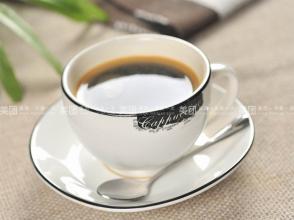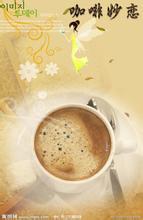The strong flavor of Puerto Rican coffee describes the degree of grinding taste characteristics of high-quality coffee beans
Puerto Ricans are the general name of the residents of United States Puerto Rico in Central America and the Caribbean. There are about 3.4 million people (1979). Spanish and English are widely used. More Catholic. The earliest inhabitants of Puerto Rico were Arawak and Caribbean Indians. In 2012, whites of European origin accounted for about 73% of the population, mixed-race people accounted for 23%, and blacks accounted for 4%. There are also more than 20,000 Americans and immigrants from other countries. 20% of the economically independent population are engaged in industry, 17.2% in commerce, 7.3% in agriculture, 17% in construction and transport, and 33.7% in service industries. [7] the citizens of Puerto Rico are all United States citizens in a complete sense, and they have the right to vote in the national election after moving to the United States. In 2011, the total GDP was US $98.76 billion, with a per capita GDP of US $26588, lower than that of the states in the United States, but the highest compared with the island countries of the Caribbean, and one of the highest economic competitiveness in the Caribbean region. [2]
According to statistics from the US Department of Commerce, in 2012, Puerto Rico's foreign trade totaled about US $44.5 billion, of which exports were about US $18.7 billion, an increase of 2.6 per cent over the same period last year and accounting for 1.2 per cent of total US exports. The top five export markets are Belgium (2.4 billion), the Netherlands (2.1 billion), Japan (1.8 billion), Italy (1.6 billion) and the United Kingdom (1.5 billion). The products with the largest export volume were chemical products (15.2 billion, accounting for 81.6% of the total exports), computers and electronic products (400 million), electrical equipment and accessories (300 million), waste and scrap (300 million), and primary metal products (200 million). [2]
Imports totaled about $25.8 billion in 2012, up 4.8 per cent from a year earlier and accounting for 1.1 per cent of total US imports. The top five sources of imports are Ireland (7.6 billion), Singapore (4.1 billion), Japan (1.9 billion), Brazil (1.3 billion) and China (860 million). The main imported products include: chemical products (14.4 billion, accounting for 55.8% of the total import value), crude oil and coal products (5.6 billion), transportation equipment (800 million), oil and gas products (600 million), food (600 million), etc.
Yaocote's choice of coffee, which is grown only on three farms in the southwest of the island, is fragrant and has a long aftertaste. This kind of coffee is very expensive and its flavor is comparable to that of any other coffee variety in the world. In the Yauco area, the coffee is owned and operated by local planters. The mountain climate here is mild, the plants have a long mature period (from October to February), and the soil is of high quality clay. Some old varieties of Arabica coffee beans are grown here, although the yield is lower than other varieties, but generally of high quality. People here have been using an ecological and intensive planting method, using only some low-toxic fertilizers and chemicals, and adopting mixed crop planting measures to make the soil more fertile. When it comes time to pick coffee beans, people walk back and forth between coffee trees, picking only fully ripe coffee beans, and then wash them in a roller device for 48 hours.
Yaocote chose coffee beans to be preserved in shells before they were shipped, and the skins were not removed until the order was shipped to ensure the best freshness of the coffee. Relevant U.S. government staff, such as FDA and USEA, will also be present when the goods are submitted, and they work to monitor producers' compliance with federal regulations. There are also staff from local appraisal boards who take one bag out of every 50 bags as samples and use international gauges to identify them. Coffee trees were introduced from Martinique to Puerto Rico (Puertp Rico) in 1736. Most of the early coffee was grown by immigrants from Corsica. By 1896, Puerto Rico was the sixth largest exporter of coffee in the world, with most coffee shipped to France, Italy, Spain and Cuba. Coffee farms flourished in the 19th century, but the rise of sugarcane and drug farming as well as the impact of hurricanes and wars made the coffee industry lag behind and is now recovering.
Puerto Rico has a low-wage system, with a per capita hourly wage of $4.20 in 1991. Still, manual workers earn more than workers in many other coffee-producing countries, as long as Hawaii and Yamaja are on a par. Another problem facing the Puerto Rican coffee industry is that Puerto Ricans have better employment prospects because of their relatively high cultural quality in the Caribbean. Yaocote's choice of coffee, which is grown only on three farms in the southwest of the island, is fragrant and has a long aftertaste. This kind of coffee is very expensive and its flavor is comparable to that of any other coffee variety in the world. In the Yauco area, the coffee is owned and operated by local plantation owners. The mountain climate here is mild, the plants have a long mature period (from October to February), and the soil is of high quality clay. Some old varieties of Arabica coffee beans are grown here, although the yield is lower than other varieties, but generally of high quality. People here have been using an ecological and intensive planting method, using only some low-toxic fertilizers and chemicals, and adopting mixed crop planting measures to make the soil more fertile. When it's time to pick coffee beans, people walk back and forth between coffee trees, picking only fully ripe coffee beans, and then washing them in a roller device for 48 hours.

Important Notice :
前街咖啡 FrontStreet Coffee has moved to new addredd:
FrontStreet Coffee Address: 315,Donghua East Road,GuangZhou
Tel:020 38364473
- Prev

Full-bodied Dominican coffee flavor description, grinding degree, taste characteristics, introduction to fine coffee beans
Coffee in Dominica is grown in highlands and lowlands, and its taste is slightly different. The upland is sour, but the taste is rich; the lowland is less sour and tastes smoother. Boutique coffee has become popular in recent years. High-quality coffee beans produced by some Dominican estates have a rich aroma, mellow taste and moderately bright sour taste, and have been bought with the more famous Puerto Rico beans or teeth.
- Next

Burundian Coffee with excellent acidity description of Burundian Coffee Flavor characteristics of Fine Coffee
There are many plateaus and mountains in Burundi, most of which are made up of the plateau on the east side of the East African Rift Valley. The national average elevation is 1600 meters, which is known as the mountain country. According to the topography of Burundi, it can be divided into three regions: the western plain, along the Ruzizi River, the Rift Albrtine plain, 774 to 1000 meters above sea level; and the central and western mountains, with an average elevation of 1700 meters, with the highest peak in Bujumbura.
Related
- Detailed explanation of Jadeite planting Land in Panamanian Jadeite Manor introduction to the grading system of Jadeite competitive bidding, Red bid, Green bid and Rose Summer
- Story of Coffee planting in Brenka region of Costa Rica Stonehenge Manor anaerobic heavy honey treatment of flavor mouth
- What's on the barrel of Blue Mountain Coffee beans?
- Can American coffee also pull flowers? How to use hot American style to pull out a good-looking pattern?
- Can you make a cold extract with coffee beans? What is the right proportion for cold-extracted coffee formula?
- Indonesian PWN Gold Mandrine Coffee Origin Features Flavor How to Chong? Mandolin coffee is American.
- A brief introduction to the flavor characteristics of Brazilian yellow bourbon coffee beans
- What is the effect of different water quality on the flavor of cold-extracted coffee? What kind of water is best for brewing coffee?
- Why do you think of Rose Summer whenever you mention Panamanian coffee?
- Introduction to the characteristics of authentic blue mountain coffee bean producing areas? What is the CIB Coffee Authority in Jamaica?

